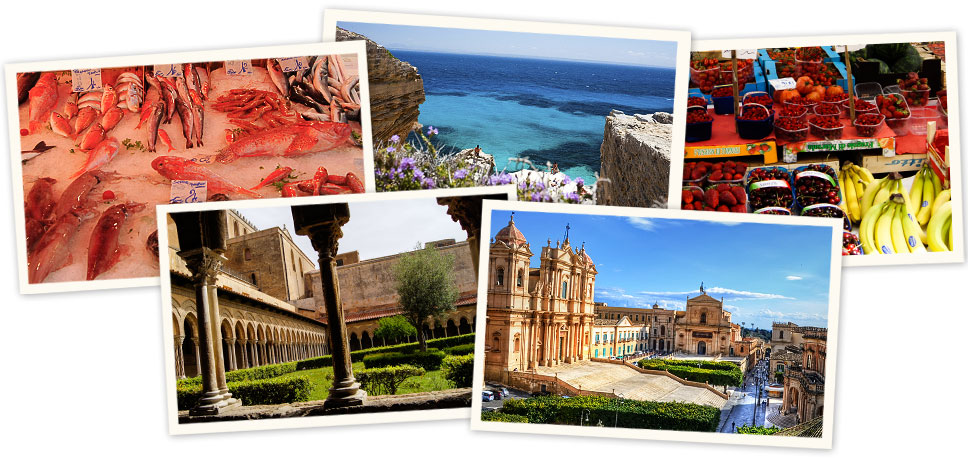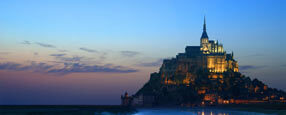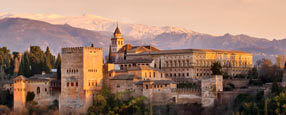SICILY AND MALTA TOUR with York College
Cost from: 4910 USD *
Single Supplement: 670 USD
* per person sharing a twin/triple.
ITINERARY IN BRIEF
Today we arrive in Palermo and transfer to our hotel.
Palermo is the capital of both the autonomous region of Sicily and the Metropolitan City of Palermo. The city is noted for its history, culture, architecture and gastronomy, playing an important role throughout much of its existence; it is over 2,700 years old. To gain an initial understanding of the city's unique culture, start by wandering the streets of the old city. The mix of architectural styles points to the wave upon wave of invaders who have claimed the city as their own, as does the look of the locals.
Overnight in Palermo.
We begin our day with a walk through the narrow streets of the Vucceria outdoor market. Here we feel the very pulse of the city's daily life, passing stalls where fishmongers display whole sword fish and tuna, and several varieties of squid and octopus. Sicily is agriculturally rich and here some of the island's excellent produce is displayed: apples from the slopes of Mount Etna; oranges and lemons, introduced to Sicily by the Arabs; prickly pears, fresh figs and grapes; fat olives, capers, zucchini blossoms, fresh ricotta and pungent pecorino cheese.
A short walk brings us to the Piazza Praetoria with its 16th century Florentine fountain, decked with renaissance nudes and animal heads. At its unveiling centuries ago, locals named it "the fountain of shame". Nearby is the Baroque Quattro Canti, the 17th century crossroads that divides the old city into four; and the Municipio, a 15th century palazzo that is Palermo's City Hall. On the Piazza Bellini we step inside the Martorana Church, a 12th century building that is a jewel of Arab-Norman architecture, its interior encrusted with byzantine mosaics.
We stop at Monreale, the Royal Mountain. Here, at the end of the 12th century, the Norman king William II had a great cathedral built to reflect the sophistication and wealth of his kingdom. Byzantine and Greek artisans were employed to cover almost every surface of its interior with costly golden mosaics depicting Christ the Pantocrator, the Apostles, and cycles from the Old and New Testaments. Next door we walk through the cloister of the Benedictine Abbey.
In the afternoon we will enjoy a COOKING CLASS in Palermo.
Overnight in Palermo.
Today we transfer to Erice and enjoy a walking tour upon arrival.
Erice sits dramatically on a promontory at over 600m (2,000 feet) above the sea. The ancients considered it a sacred place; the Arabs called it Jebel Hamid, or Blessed Mountain. We enter the Carthginian Porta Trapani, passing the Chiesa Matrice, a beautiful Normanesque Gothic church built in the 15th century. Near the main square you might like to sample some Sicilian sweets at a local shop where they are made to order. The Arabs are credited with the introduction of the local fondness of desserts, including gelato for which Sicily is famous. On a clear day, we might even see the coast of Tunisia, 145km distant. Erice is home today to an important scientific institute where international conferences and symposia are held year round, giving Erice the sobriquet, "City of Science".
We transfer to Marsala and visit the salt pans for which this area is famous. We will learn the process that is involved in producing salt.
Overnight in Marsala.
This morning we depart Marsala and stop at the magnificent series of temples of Agrigento for a guided tour.
Founded as a Greek colony in the 6th century BCE, Agrigento became one of the leading cities in the Mediterranean world. Its supremacy and pride are demonstrated by the remains of the magnificent Doric temples that dominate the ancient town, much of which still lies intact under today's fields and orchards. Selected excavated areas throw light on the later Hellenistic and Roman town and the burial practices of its early Christian inhabitants.
The five elevated temples are a picture-perfect tribute to the indomitably of paganism. Time, earthquakes, vicious Punic Wars, and the rise of Christianity have taken their toll, and the temples have been named official World Heritage landmarks.
In the afternoon transfer to Ragusa, one of the most picturesque towns in Sicily. The view from the upper town over Ragusa Ibla on its own separate hilltop is quite breathtaking. One of the UNESCO-listed Baroque towns of south-eastern Sicily, originally built on a small steep-sided hill with deep valleys on three sides separating it from the high plateau. After the earthquake of 1693, which destroyed many of south-eastern Sicily's buildings, it was decided to rebuild Ragusa on higher, more level ground nearby. This new planned town was built, with straight streets and a rational layout, but local aristocrats didn't want to move, and instead built themselves new palazzi on the ruins of the old town. So nowadays Ragusa has two parts: Ibla (or Ragusa Ibla), the older nucleus on its hilltop, and Ragusa Superiore, the more modern upper town.
Overnight in Ragusa
Today we visit Modica in the Noto Valley, A UNESCO site known for the production of chocolate.
Like Ragusa, the town was badly damaged in the 1693 earthquake and largely rebuilt in Sicilian Baroque style. It is divided into two parts, "higher" Modica and "lower" Modica, which are connected by numerous flights of steps. Palazzi and houses rise from the bottom of the gorge seemingly stacked one on top of the other. Magnificent churches, with their inspiring domes, bell towers and intricate facades, punctuate the red-tiled roofs and one is struck by the uniform beauty of the whole. The centrepiece is undoubtedly the beautiful Church of San Giorgio, though the "Castello dei Conti", surveying the town from atop a rocky outcrop, is also very impressive.
Modica is custodian of a 400 year tradition of Sicilian chocolate-making. Being part of the Spanish kingdom for so many years meant that Sicily was often one of the first recipients of the new foodstuffs being brought back from South America. Cacao was one of these and today Modica still specializes in making granulous chocolate, often flavoured with chilli pepper, cinnamon or vanilla, that is based on Aztec methods and recipes. While here we will visit a chocolate factory and taste the main products.
Back in Ragusa, we'll have a tour of Ragusa Ibla, the historical centre where we can admire the baroque art and architecture.
Overnight in Ragusa.
This morning we leave Ragusa for a day trip to Caltagirone, renown for ceramics.
Swirling patterns, vibrant colours, painstakingly detailed designs, wherever you go in Caltagirone this is what you will see -- ceramics is the name of the game and it has been for millenia. Virtually all buildings in the old town are decorated with ceramic tiles, shops spill their delightfully crafted wares onto the pavements, and the effect is one of multichromatic vivacity.
The highlight is undoubtedly the 142 steps of the Scalinata di Santa Maria del Monte that connect the lower town with the older upper town.
We will visit the town and then enjoy an informative and hands-on ceramics class during which we will have the opportunity to decorate our own pottery.
We return to Ragusa for overnight.
Overnight in Ragusa.
Today we say arrivederci to Ragusa and travel to Syracusa (Syracuse) and tour the Archaeological Park, including the Greek theatre, Monumental Altar of Hieron II, and the Latomia del Paradiso (quarry with the Ear of Dionysius).
After a break for lunch we have a walking tour of Ortygia (old Siracusa), wandering the narrow streets of the old city where we see the Temple of Apollo, Fountain of Aretusa, the main piazza, and the Duomo, a former Temple of Athena. Free time to explore the city.
We continue to Catania, the 'city of lava' standing in the ominous shadow of Mount Etna - indeed the city was almost completely buried by lava flows in 1669. The town is also called the 'city of black and whitE': white plaster and marble and black lava comprise much of its architectural adornment. On arrival we have a leisurely walking tour of the town.
Overnight in Catania.
Today we will visit Mount Etna, the highest of Europes volcanoes. Travelling in 4x4 jeeps, we'll drive up the side of Etna -- have a sweater handy as we'll be approaching 1800m / 6,000 ft! This is the highest volcano in Europe and one of most active of the world; its spectacular eruptions and its fiery lava flows have always aroused the interest of scientists, along with the curiosity of visitors from all over the world. Well take some time to walk a bit at about 2000 metres (6,500 ft).
On our way back to Catania well stop at Bronte, famous worldwide for the production of pistachios. The pistachio plant can live between 200 and 300 years, and thrives above all in Bronte. While the nuts most ancient origins lie in ancient Persia, that grown in Bronte is distinguished by very unique characteristics - even in comparison to other Sicilian pistachios - and is thus known as pistacia vera. Whether fresh or dried, it is perhaps the most precious ingredient in Sicilian cuisine, and symbolizes its town of origins in Bronte. Indeed, the pistachio is so important to Brontes economy that it has long been graced with the nickname "green gold."
Overnight in Catania
This morning well tour Catania before heading to Taormina for a tour of this stunning town.
Catania has its own magnetic pull and youthful energy. The city itself is over 2,700 years old and is full of UNESCO listed sites. Today our tour will afford you ample time to explore the historic sites of this city, while at the same time enjoying its extraordinary cuisine. Our tour will also visit the nearby picturesque villages of Acicastello.
Later well drive up the east coast to Taormina with stunning views of Mt. Etna en route (weather-permitting!) On arrival in Taormina we'll have a leisurely walking tour of the town, starting with the almost perfectly preserved Greco Roman amphitheatre, Taormina's greatest treasure. In ancient days, the 3rd-century cliff-side arena seated 5,000 spectators, with Mount Etna framed perfectly as a backdrop to the 1,800 year old stage. We see also the Palazzo Corvaia with its blend of Arab, Norman, and Catalan elements where, in 1410, Sicily's first parliament was convened. The Corso Umberto I is a charming pedestrian street that runs the length of town.
There are many shops and boutiques along the way and at the Piazza IX Aprile, with lovely views of Naxos harbour and the Italian mainland across the straits. In the Piazza del Duomo, where Taormina's 15th century basilica/cathedral stands, is a fountain topped by the symbol of the town: the statue of a female centaur. Return to Catania.
At some point during our time in Catania, well enjoy a street food tour including lunch in the market.
Overnight in Catania.
Today we say arrivederci to Sicily and onto Malta with a ferry departure from Catania.
Welcome to Malta! Today we will enjoy a Harbour Cruise and Valetta Walking Tour.
Malta has a greater density of historic sights than almost any other country. With over 7,000 years of history, Malta is the ultimate destination for any history buff, as the islands have also played host to the Phoenicians, the Romans, the Knights of St. John, Napoleon and the British Empire. A small but strategically important group of islands, the archipelago has through its long and turbulent history played a vital role in the struggles of a succession of powers for domination of the Mediterranean and in the interplay between emerging Europe and the older cultures of Africa and the Middle East. As a result, Maltese society has been molded by centuries of foreign rule by various powers.
We start our sightseeing with a wonderful cruise around the two natural harbours on either side of Valletta, Marsamxett Harbour and the Grand Harbour. The detailed commentary will present the history of Valletta and the Three Cities as well as other places of interest including the historical forts and battlements which are best admired from a cruise. The harbours, creeks, shipyards, skyline and bastions of Valletta, and the "Three Cities" are unforgettable.
We later depart on foot for our exploration of Valletta, the capital of Malta. Valletta is arguably the smallest capital in Europe -- the entire city is only 1000m (1 km) long and 600m wide! Jean Parisot de la Valette, the Grand Master of the Order of the Knights of St. John, founded the city in 1566 following the Knights' defeat of the Ottoman Turks during the "Great Siege of Malta". Massive fortifications on the seaward side were built, and a defensive ditch on the landward side. The city inside the walls was then laid out on a regular street grid pattern, and adorned with churches, palaces, auberges (inns), and the famous hospital of the Knights, the Sacra Infermeria. The Upper Barakka Gardens provide magnificent views of the Grand Harbour, and the fortified peninsulas of Senglea and Vittoriosa. We will visit the Grand Master's Palace, today the official residence of the President of Malta and the seat of parliament. The palace housed the residence and state rooms of the Grand Masters from 1571 until their expulsion by Napoleon in 1798.
During our time in the walled city we will break for lunch allowing you to enjoy one of the many sidewalk cafes and restaurants. Your local guide will likely point you in the direction of one of the most famous Maltese foods the pastizzi! These are quite easy to find and very inexpensive. Coming in various flavors, pastizzi are sizable phyllo dough pastries that were traditionally stuffed with ricotta cheese. Today you can find various fillings.
This afternoon we will see the 45 minute film "The Malta Experience," an excellent audiovisual documentary providing a detailed overview of the history of the island. The film is screened in the 16th century hospital of the Knights of St. John -- the Sacra Infermeria -- famous throughout Europe for its sheer size and highest standards of care.
Overnight in Malta.
Today we will enjoy a half-day tour and discover the 'Silent City' or Mdina as well as adjacent Rabat. With human settlement dating back to as far as 2500 BCE, Mdina, Malta's former capital, is situated on a hilltop in the central part of the island. One of Europe's finest examples of an ancient walled city, Mdina exhibits an extraordinary mix of medieval and baroque architecture and is one of the main highlights of the island. Here was can admire its medieval fortifications on entry to the city, then we will enjoy a walking tour where you'll spot the baroque Mdina Gate, early 18th century St. Paul's Cathedral, and numerous historic noble palaces which line its narrow, shaded streets.
After strolling through Mdina we will continue on to Rabat which also has characteristic winding, narrow streets. Like Mdina, Rabat also played a major role in Malta's past, and is a prime source of its cultural heritage. According to tradition, the Apostle St. Paul is said to have shipwrecked on the island around 60 AD, and subsequently opted to reside for three months inside a cave in Rabat known as Fuori le Mura, now known as St. Paul's Grotto. We will meander Rabat's winding streets, and admire the Basilica of St. Paul, built above the historic grotto.
Malta's landscape contrasts rocky stretches of coast that end in dizzying limestone cliffs with sheltered bays that hide gin-clear water and red-gold beaches, and we end our tour with a drive to the south coast of the island. We will stop for the beautiful panorama at the 220m high Dingli cliffs with its magnificent views. From here we head east for a visit to the fishing village of Marsaxlokk where we enjoy a late lunch at one of the small town's many restaurants, which front a harbour full of bobbing, colourful boats. A walk along the Marsaxlokk harbour presents local fishermen busy mending their fishing nets in the street and fleets of colourful traditional Maltese boats (called Luzzu) still in use to this day. Restaurants and cafes line the waterfront so you are spoilt for choice if the sea air suddenly brings on your appetite.
From here it is just a short drive back to our hotel for our last night.
Overnight on Malta
Today we will depart from Malta and fly back home.
INCLUSIONS
- Accommodation in 3 star hotels on a triple or twin share
- Sightseeing and entrance fees as per itinerary
- Transportation in a private coach
- Local guides
- Breakfast daily
- 2 Lunches
- Air fare from IAD to Palermo and return from Malta
EXCLUSIONS
- Items of a personal nature
- Travel insurance
- Gratuities to local guides and driver
- Cost of COVID tests that may be required upon departure and return
TOUR SAFETY
Global Educational Travel has implemented new safety measures and has received the World Travel and Tourism Council's Safe Travels stamp, which provides travellers with the assurance that we have adopted health and hygiene global standardised protocols – so you can experience 'Safe Travels'.
Click here for more info
LOOKING FOR INSPIRATION?








